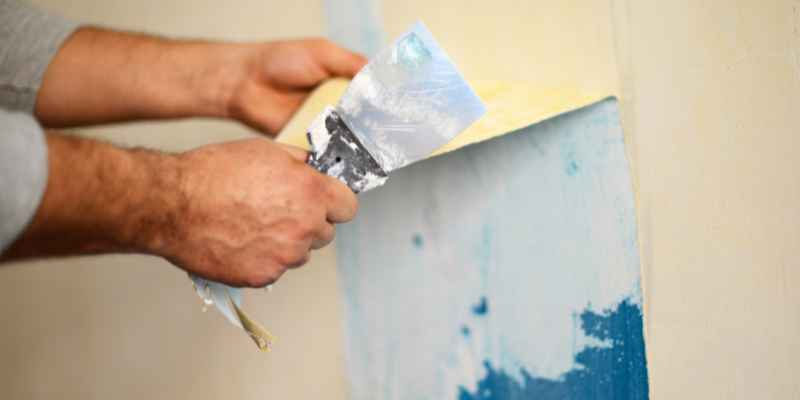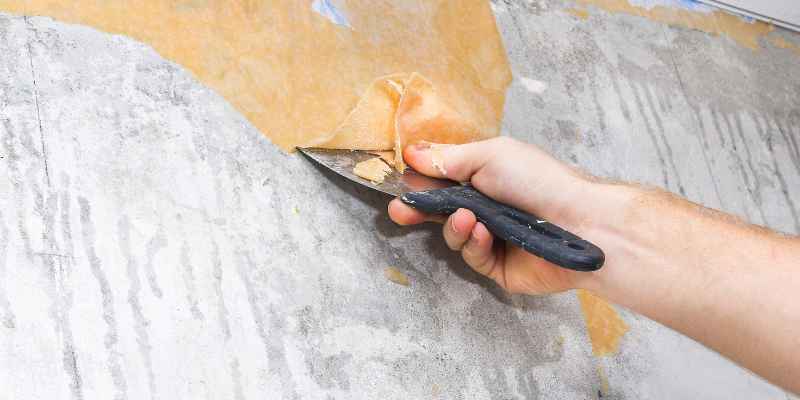Yes, vinegar can remove paint from wood effectively. When combined with water or used alone, vinegar acts as a natural and eco-friendly paint stripper, making it a popular choice for removing paint from wood surfaces.
Its acidic properties help break down the paint, making it easier to scrape or wipe away. Additionally, vinegar is a safe and non-toxic option compared to harsh chemical paint strippers, making it a preferred choice for those concerned about their health and the environment.
Whether you’re trying to restore an old wooden piece or remove accidental paint splatters, vinegar can be an effective and affordable solution for removing paint from wood.
How Does Vinegar Remove Paint From Wood?
Vinegar, a common household item, can be surprisingly effective in removing paint from wood surfaces. Its acidic nature and natural properties make it a safe and eco-friendly alternative to harsh chemical paint strippers. Understanding how vinegar removes paint from wood can help you tackle your paint removal projects with confidence.
Acidic Nature Of Vinegar
Vinegar is often praised for its versatility in cooking and cleaning, but its acidic nature also makes it an excellent paint remover. The main component of vinegar is acetic acid, which reacts with various substances, including paint. The acidity of vinegar helps break down the bonds between the paint and the wood, making it easier to remove.
Breaking Down The Paint
When vinegar comes into contact with paint on wood, it acts as a natural solvent. It softens the paint, making it more susceptible to being scraped or peeled off. The acetic acid in vinegar reacts with the chemical compounds in the paint, causing it to loosen and lose its adhesion to the wood surface. As a result, the paint becomes easier to remove without damaging the wood underneath.
Removing Multiple Layers Of Paint
Vinegar can be particularly effective in removing multiple layers of paint from wood surfaces. Its ability to break down the paint allows it to penetrate through the layers and reach the underlying wood. This makes it easier to remove each layer individually, without the need for excessive scraping or sanding. By applying vinegar and allowing it to sit on the paint for a period of time, you can gradually strip away the layers of paint to reveal the natural beauty of the wood.

Benefits Of Using Vinegar To Remove Paint From Wood
Vinegar has long been used as a natural cleaning agent due to its powerful properties and versatility. When it comes to removing paint from wood, vinegar proves to be a beneficial and eco-friendly option. Let’s explore the reasons why vinegar is a great choice for paint removal.
Environmentally Friendly
Vinegar is an environmentally friendly solution that is free from harmful chemicals. Unlike traditional paint strippers that contain toxic ingredients, vinegar is biodegradable and does not release harmful fumes into the environment. By opting for vinegar to remove paint from wood, you can minimize your carbon footprint and contribute to a healthier planet.
Non-toxic
One of the major advantages of using vinegar to remove paint from wood is its non-toxic nature. With vinegar, you don’t have to worry about exposing yourself or your loved ones to harmful substances. Whether you’re working on a small home project or tackling a larger painting removal job, vinegar provides a safe and effective alternative that is gentle on both your health and the wood surface.
Affordable And Easily Accessible
Vinegar is not only environmentally friendly and non-toxic but also highly affordable and easily accessible. You can find vinegar in almost every grocery store at a fraction of the cost of commercial paint removers. This makes vinegar an economical choice for paint removal, particularly if you’re working on a tight budget. With this simple yet effective solution readily available, you can tackle your paint removal tasks without breaking the bank.
Step-by-step Guide To Remove Paint From Wood Using Vinegar
Removing paint from wood can be a daunting task, but with the right technique, it can be done effectively using a simple ingredient found in most households – vinegar. Vinegar’s acidic properties make it a natural and eco-friendly option for paint removal on wood surfaces. In this step-by-step guide, we will walk you through the process of removing paint from wood using vinegar.
Gather The Necessary Materials
Before you begin, make sure you have all the necessary materials on hand. Here’s what you’ll need:
- White vinegar
- Clean cloth or sponge
- Plastic wrap
- Paint scraper or putty knife
- Bucket
- Warm water
- Mild soap
Prepare The Vinegar Solution
Now that you have gathered the materials, it’s time to prepare the vinegar solution. Follow these steps:
- Mix equal parts of white vinegar and warm water in a bucket. For instance, if you use one cup of vinegar, add one cup of warm water.
- Stir the solution well until it’s thoroughly combined.
Apply The Vinegar Solution
With the vinegar solution ready, it’s time to apply it to the painted wood. Here’s how:
- Dip a clean cloth or sponge into the vinegar solution.
- Apply the solution to the painted wood, making sure to cover the entire painted surface.
- Allow the vinegar solution to sit on the paint for about 15-20 minutes. This will loosen the paint and make it easier to remove.
Scrape Off The Paint
After the vinegar solution has had time to work its magic, it’s time to scrape off the paint. Follow these steps:
- Using a paint scraper or putty knife, gently scrape off the loosened paint. Be careful not to scratch or damage the wood surface.
- If needed, repeat the application of the vinegar solution and scraping until all the paint is removed.
Clean And Restore The Wood
Once the paint is removed, it’s important to clean and restore the wood to its original condition. Follow these steps:
- Fill a bucket with warm water and add a small amount of mild soap.
- Dip a clean cloth or sponge into the soapy water and gently wipe down the wood surface to remove any remaining vinegar solution and paint residue.
- Rinse the cloth or sponge with clean water and wipe down the wood again to remove any soap residue.
- Dry the wood thoroughly with a clean towel.
And there you have it – a step-by-step guide to remove paint from wood using vinegar. By following these simple steps, you can effectively remove paint from wood surfaces and restore them to their natural beauty.
Precautions And Tips For Using Vinegar To Remove Paint From Wood
When it comes to removing paint from wood, vinegar can be a cost-effective and natural alternative to harsh chemical solvents. However, it’s important to take certain precautions and follow some tips to ensure the best results and protect your wood surfaces. Keep reading to learn the key precautions and tips for using vinegar to remove paint from wood.
Test In An Inconspicuous Area
Before you start using vinegar to remove paint from wood, it’s always wise to test its effects in an inconspicuous area. This will help you determine whether vinegar is suitable for your specific wood surface and how long it may take to remove the paint. Apply a small amount of vinegar onto a hidden area of the wood, let it sit for a few minutes, and then wipe it off.
Use Safety Equipment
Protecting yourself is just as important as protecting your wood surface. When using vinegar to remove paint from wood, it’s crucial to use safety equipment. Wear protective gloves, safety goggles, and a mask to prevent direct contact with the vinegar or paint particles, which may release harmful fumes or cause skin irritation.
Ventilate The Area
Proper ventilation is essential when working with vinegar as a paint remover. Open windows and doors or use fans to ensure good air circulation. This will help prevent the buildup of vinegar fumes in the area and minimize any potential health risks. Ventilating the workspace is especially important if you’re working indoors or in a confined space.
Work In Small Sections
When removing paint from wood with vinegar, it’s recommended that you work in small sections. Applying vinegar to the entire wood surface at once can lead to the vinegar drying out before it has a chance to penetrate the paint and soften it. By working in small sections, you can focus on one area at a time, allowing the vinegar enough time to effectively break down the paint.
Apply Multiple Applications If Needed
Sometimes, removing stubborn paint requires multiple applications of vinegar. If a single application doesn’t fully remove the paint, allow the area to dry and then reapply vinegar. This process can be repeated until the paint is completely dissolved. Just be patient and persistent, and avoid rushing the process to prevent any damage to the wood surface.

Alternatives To Vinegar For Removing Paint From Wood
While vinegar is a popular and eco-friendly option for removing paint from wood, there are several alternative methods you can consider. These alternatives provide effective solutions for removing paint from wood surfaces without causing any damage. In this section, we’ll explore three common alternatives to vinegar: Commercial Paint Strippers, Heat Gun Method, and Sanding Method.
Commercial Paint Strippers
Commercial paint strippers are readily available in the market and offer a powerful way to remove paint from wood. These strippers contain specialized chemicals that break down the paint, making it easier to scrape or wash away. When using a commercial paint stripper, it’s important to follow the manufacturer’s instructions carefully and take necessary safety precautions. Here are some key advantages of using commercial paint strippers:
- Wide availability in various brands and formulations
- Effective in removing multiple layers of paint
- Fast-acting and time-saving compared to other methods
- Suitable for large surface areas or intricate woodwork
Remember to apply the commercial paint stripper evenly and allow sufficient time for it to penetrate the layers of paint before removing. Use a scraper or a brush to aid in the removal process, and be sure to clean up any residue properly. Always wear protective gloves, goggles, and a mask when working with commercial paint strippers.
Heat Gun Method
The heat gun method is another effective way to remove paint from wood surfaces. This method involves using a heat gun to soften the paint, making it easier to scrape off. Here’s why the heat gun method can be a suitable alternative to vinegar:
- Effective for removing stubborn or thick layers of paint
- Allows precise control over the heat application
- Does not involve the use of harsh chemicals
- Can be used on various types of wood
When using a heat gun, make sure to keep the gun at a safe distance from the wood to avoid scorching or igniting the surface. Always work in a well-ventilated area and consider wearing heat-resistant gloves to protect your hands. Remember to scrape off the softened paint gently to prevent damaging the wood beneath.
Sanding Method
The sanding method is a traditional approach to remove paint from wood surfaces. It involves using sandpaper or a sanding machine to gradually wear away the layers of paint. Here are some advantages of using the sanding method:
- Allows complete removal of paint, revealing the natural wood
- Provides control over the amount of paint removed
- Can be used for intricate woodwork or small areas
- Affordable and doesn’t require specialized tools
When using the sanding method, start with coarse-grit sandpaper and gradually move to finer grits for a smooth finish. Work in the direction of the wood grain and be patient to achieve the desired results. Remember to wear a dust mask to protect yourself from inhaling the paint particles and regularly clean the sandpaper to maintain its effectiveness.
Conclusion
To wrap things up, vinegar can indeed remove paint from wood effectively. Its acidic properties work wonders in breaking down the paint particles, making it easier to scrape or wipe away. However, caution is still necessary, as excessive use of vinegar may damage the wood surface.
It is always recommended to test a small inconspicuous area before proceeding with large-scale paint removal. Make sure to follow proper safety measures and choose the right technique for your specific situation. Happy painting!


